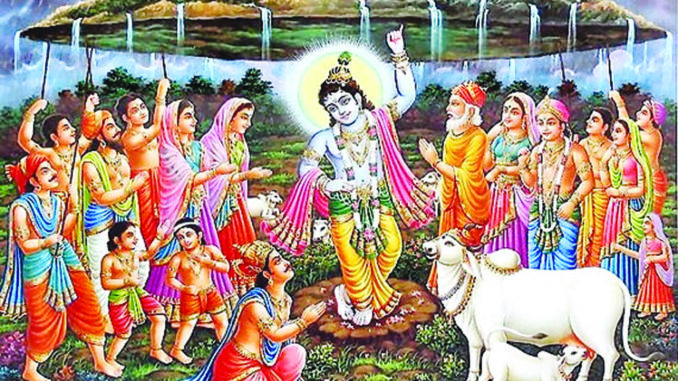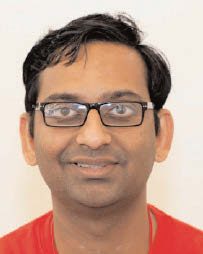
Govardhan Pooja, one of the auspicious festival of the Hindus, is celebrated a day after the Diwali in the month of Kartik. Also known as Bali Pratipada, on this occasion, devotees offer puja to Lord Krishna. According to Hindu religion, this pooja marks the victory of Lord Krishna over the arrogance of Lord Indra. People also worship the pile of grains (symbolizing the Govardhan mountain) on the day.
Commemorating the history of Govardhan Parbat, on this occasion people remember how Lord Krishna saved the lives many people’s lives during unprecedented rain. Going by the Hindu mythology, Lord Krishna asked the people of Vrindavan to worship nature. He told people to worship the Govardhan Hill and stop worshipping Lord Indra. The message by Lord Krishna was mainly to make people understand the importance of nature. But Lord Indra, who is also known as the God of rain, was angry with the teachings of Lord Krishna and he started heavy rain on Gokul. In a bid to protect people, Lord Krishna lifted the Govardhan hill on his little finger and provided shelter to the people under it.
Devotees perform this pooja by making hillocks of cow-dung which represents the Mount Govardhan. They decorate it with flowers and worship them. People also pray to Lord Krishna who taught people to worship the nature.
Date and time
– This year, Govardhan puja will be celebrated on November 15.
-The Pratipada tithi begins at 10:36 AM on November 15 and ends at 7:06 AM on November 16
– The puja time or shubh muhurat is between 3:19 PM to 5:27 PM as per the drikpanchang.
Rules and Procedure
– On the day of Govardhan Pooja, Govardhan made from cow dung is made and are bedecked with flowers. Usually Govardhan Puja is done either in the morning or in the evening. During the Pooja, water, fruits, incense sticks and oblation are offered to Govardhan. Also on this very day, cow-bull and animals used for agricultural purposes are also worshiped.
– An effigy of Govardhan Ji is made from cow dung on the ground and a clay lamp is placed on the naval. Put milk, curd, gangajal, honey, crystallized sugar (bataashe) in the lamp during the puja time and after that prasad is distributed.
– After the puja, everyone hails for Govardhan Ji while revolving around the idol. While doing this, water from a vessel is made to spill and the revolution is completed by sowing the barley on the ground.
– Govardhan Giri is known as a form of God and worshiping him on this day strengthens you financially, auspicious for the betterment of children, and for enhancing the cow milk.
– On the day of Govardhan Pooja, Lord Vishwakarma is also worshiped. On this occasion, machines are also worshiped in the factories and industries.
Bhai dooj
The festival Bhai Dooj is the one, that signifies the special connection between a brother and a sister. The bond which unlike any other, stands out from the rest in its own and special way. This special connection is also known as Bhai Teeka, Yam dwitiya, Bhrat dwitya etc. Bhai Dooj usually falls on the dark lunar fortnight, in the month of Kartik. This date falls right after Diwali, 2 days to be exact. On this occasion, the sister’s apply a tilak and pray for the long life for their brothers. The Brother returns the favour by bringing her presents and gifts for all the toils the sister does for him. On Bhai Dooj, people venerate and worship the god of death Yamraj. As per the traditional beliefs, the god of death Yamraj was on hand to answer her sister’s call as he paid her a visit for lunch.
Bhai Dooj Muhurat
n Bhai Dooj Tilak Time :13:10:03 to 15:18:27
n Duration :2 Hour 8 Minute
Rituals
n On the eve of Bhai Dooj, the plate from which the brother is to be worshipped is decorated appropriately or should we say festively. The plate has to have vermillion, sandal, fruits, flowers, sweets and, betel nut.
n Before the Tilak ceremony takes place, chalk out a square with rice.
n On this very square, the brother is seated as he waits for the auspicious timing, when the sister finally applies the tilak.
n Post Tilak give fruits, betel nut, crystallized sugar, betel leaf, black grams to your brother before performing an aarti on him.
n Once the Tilak and Aarti is done, the brother presents his sister with a gift before taking a vow to protect her for life.
Legend
Every Hindu festival obviously has to have an enthralling background story about it, which usually is a very feisty and sensitive affair. Similarly, Bhai Dooj has an enthralling fable about it. This story tells a lot about the significance and focuses a lot on its importance as well.
The Saga of Yam and Yami
According to a famous mythological chronicle, the god of death Yamraj gave his sister, Yamuna a visit, which later became the tradition of Bhai Dooj, that would be followed for a thousand of years to come. The children of Sun God were Yam and Yami, who were brother and sister. After pestering Yam countless of times, Yami finally got her wish fulfilled. Her brother finally gave in to her demands and paid her a visit. On this occasion, Yamuna made sure that her brother ate out of her hands in the most literal of senses.
After lunch she applied a tilak on his forehead, and prayed for his long life. Being on the receiving end of such affection and love, Yamraj asked his sister for a boon. The sweet sister that she was, she replied that she just wishes that he visits her every year and any sister who does the rituals and applies the tilak shall not ever fear the god of death Yamraj. Hearing the sweet wish of his sister Yamraj was very pleased as he blessed his sister and granted her wish. From this day, the tradition of Bhai Dooj picked up and it became a phenomena which would be followed till the present day. To bathe in the holy river of Yamuna is considered of great importance as it is widely believed, if the brother and the sister take a dip in the holy river, they achieve rewards in the form of a better life with less troubles.
The Tale of Krishna and Subhadra
As far as other stories go about how we started to celebrate Bhai Dooj, one such tale involves Lord Krishna. When he returned home after killing the devil Narkasur, his sister (Subhadra) welcomed him with flowers,fruits and sweets. She also lit up diyas and gave him an exquisite welcome. She applied a tilak on his forehead before praying that he lives on for a thousand more years. From that day onwards, it became a custom to apply tilak on the forehead of the brother and in return the brother presents his sister with an alluring gift.





Be the first to comment